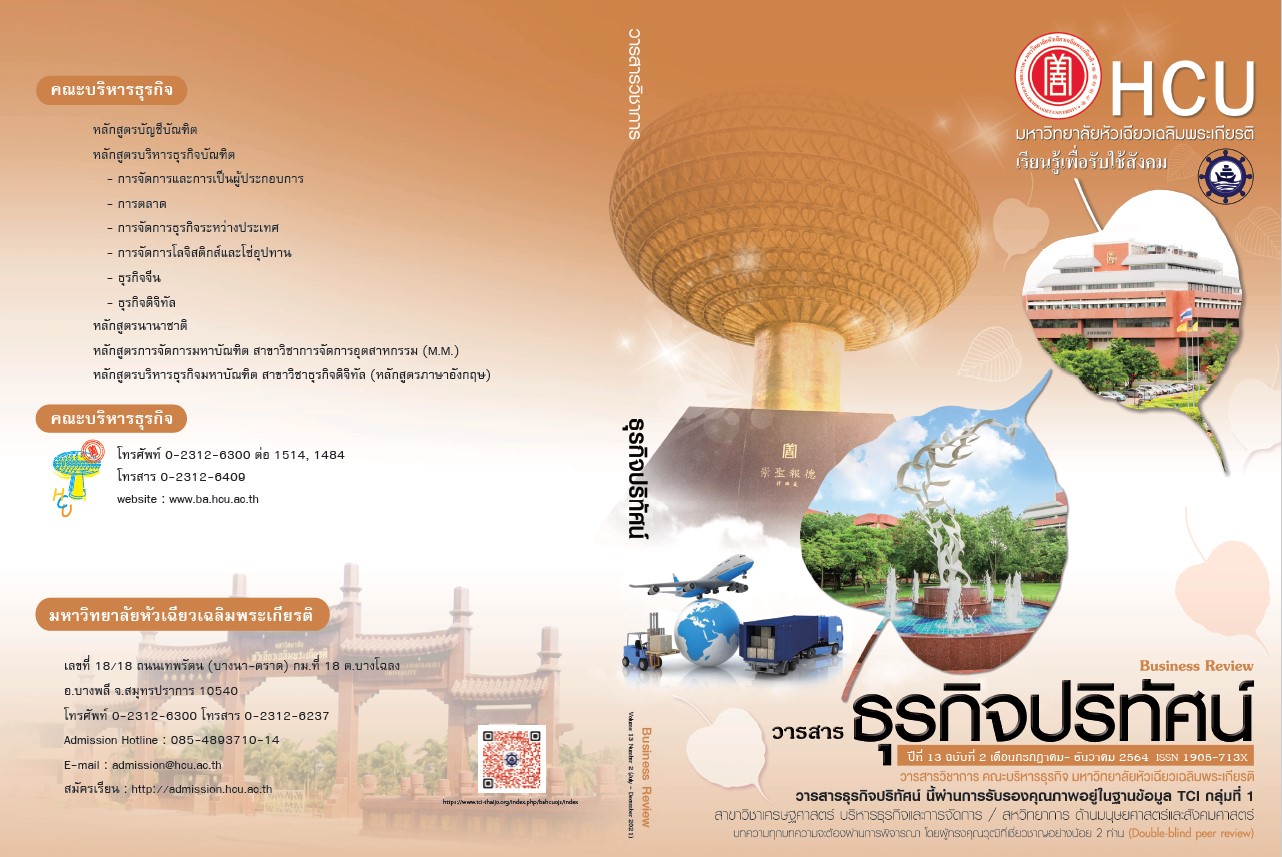Analysis of Internal and External Sources of Knowledge for Open Innovation Management of Thai Automotive Industry
Keywords:
Research and Development, Sources of Knowledge, Open Innovation, Automotive IndustryAbstract
The purpose of this research was to examine and apply the sources of knowledge to create open innovation of the Thai automotive industry. The literature review was able to identify 11 main sources of knowledge for this study through a group meeting with executives in the automotive industry. Data were collected through in-depth interviews and visits of factories chosen from the selected companies. Analyze the data by considering the percentage of total source of knowledge obtained from the interviews of all 5 companies. To find common factors of knowledge sources that are used in the organization. Then analyze by dividing the sources of knowledge according to the sources of knowledge that are found as a group of internal sources and external sources.
The results indicated that the top four sources of knowledge used in the automotive industry were (1) in-house R&D, (2) joint with customer, which corresponds to the dimension of the new marketing with a concept of customer co-creation, (3) trial and error, and (4) best practice.
References
กรมทรัพย์สินทางปัญญา (2559). จำนวนสิทธิบัตรจดทะเบียนแยกตามประเทศ. สืบค้นเมื่อ 3 มกราคม 2559, เว็บไซต์: https://www.ipthailand.go.th/th/patent-012.html
ปรเมศวร์ เอี่ยมอุไร และคณะ. (2563) a. กรอบแนวคิดการพัฒนาทรัพยากรมนุษย์ด้านนวัตกรรมขององค์การธุรกิจไทยในยุคดิจิตอล. วารสารมนุษยศาสตร์และสังคมศาสตร์มหาวิทยาลัยธนบุรี, 14(2), 144-153.
ปรเมศวร์ เอี่ยมอุไร และคณะ. (2563) b. อิทธิพลของปัจจัยการสนับสนุนด้านความรู้จากองค์การและจากตัวพนักงานที่มีต่อศักยภาพด้านนวัตกรรมในอุตสาหกรรมยานยนต์ไทย ภายใต้ตัวแปรกำกับประเภทผู้ผลิต. วารสารวิชาการบริหารธุรกิจ สมาคมสถาบันอุดมศึกษาเอกชนแห่งประเทศไทย ในพระราชูปถัมภ์สมเด็จพระเทพรัตนราชสุดาฯ สยามบรมราชกุมารี, 9(1), 22-43.
Belussi, F., Rullani, E., & Gottardi, G. (2002). Knowledge creation, collective learning and variety of institutional arrangements. London: Kluwer Press.
Capello, R. (1999). Spatial transfer of knowledge in high technology milieu: Learning versus collective learning processes. Regional Studies, 33(4), 353-365.
Chesbrough, H. W. (2003). Open Innovation: The New Imperative for Creating and Profiting from Technology. Boston, Massachusetts: Harvard Business School Press, 37(1), 15-30.
Chesbrough, H. W. (2004). Managing Open Innovation. Research-Technology Management, 47(1), 23-26.
Claycomb, C., Droge, C., & Germain, R. (2005). Applied Customer Knowledge in a Manufacturing Environment: Flexibility for Industrial Firms. Industrial Marketing Management, 34(6), 629-640.
Cohen, W. M., & Levinthal, D. A. (1990). Absorbtive capacity: A New Perspective on Learning and Innovation (Special Issue). Administrative Science Quarterly, 35(1), 128-152.
Cooke, P. (2010). Organizing Regional Innovation Support: Sweden’s Industrial Development Centres as Regional Development Coalitions. European Planning Studies, 18(11), 1909-1910.
Davenport, T. H., Harris, J. G., & Kohli, A. K. (2001). How do They Know Their Customers So Well?. MIT Sloan Management Review, 42(2), 63-73.
Hadjimanolis, A. (1999). Barriers to innovation for SMEs in a small less developed country (Cyprus). Technovation, 19(9), 561-570.
Johnson, B., Lorenz, E., & Lundvall, B. A. (2002). Why all this fuss about codified and tacit knowledge?. Industrial and Corporate Change, 11(2), 245–262.
Lundvall, B., & Nielsen, P. (1999). Competition and transformation in the learning economy: The Danish case. Revue d’Economie Industrielle, 88(2), 67-90.
McAdam, R., McConvery, T., & Armstrong, G. (2004). Barriers to innovation within small firms in a peripheral location. International Journal of Entrepreneurial Behavior & Research, 10(3), 206-221.
Pavitt, K. (1998). Technologies, Products and Organization in the Innovating Firm: What Adam Smith Tells Us and Joseph Schumpeter Doesn’t. Industrial and Corporate Chang, 7(3), 433-452.
Poramet, E., Napaporn, K., & Rapeepun, P. (2019). A Study of Intrinsic Factors and Extrinsic Factors that Affect the Knowledge Absorption of Employee’s in the Thai Automotive Industry. Journal of Engineering and Applied Sciences, 14(21), 8109-8113.
Reichwald, R., & Piller, F. (2006). Interaktive Wertschopfung. Open Innovation, Individualisierung und neue Formen der Arbeitsteilung. Gabler: Wiesbaden Press.
Rowley, J. (2002). Eight Questions for Customer Knowledge Management in e-Business. Journal of Knowledge Management, 6(5), 500-511.
Sabir, R. I., & Sabir, R. M. (2010). Managing technological innovation: China’s strategy and challenges. Journal of Technology Management in China, 5(3), 213-226.
Salomann, H., Dous, M., Kolbe, L., & Brenner, W. (2005). Rejuvenating Customer Management: How to Make Knowledge For, From and About Customers Work. European Management Journal, 23(4), 392-403.
Santos, D. (2000). Innovation and Territory: Which Strategies to Promote Regional Innovation Systems in Portugal?. European Urban and Regional Studies, 7(2), 147-157.
Steiner, M., & Hartmann, C. (2006). Organizational learning in clusters: A case study on material and immaterial dimensions of cooperation. Regional Studies, 40(5), 493-506.
Thorpe, R., Holt, R., Macpherson, A., & Pittaway, L. (2005). Using knowledge within small and medium-sized firms: A systematic review of the evidence. International Journal of Management Reviews, 7(4), 257-281.
Xie, X. M., Zeng, S. X., & Tam, C. M. (2010). Overcoming barriers to innovation in SMEs in China: A perspective based cooperation network. Journal Innovation: Organization & Management, 12(3), 298-310.
Yeung, H. W. C. (2005). The Firm as Social Networks: An Organizational Perspective. Growth and Change, 36(3), 307-328.
Zanjani, M. S., Rouzbehani, R., & Dabbagh, H. (2008). Proposing a Conceptual Model of Customer Knowledge Management: A Study of CKM Tools in British Dotcoms. International Journal of Social, Behavioral, Educational, Economic, Business and Industrial Engineering, 2(2), 51-55.
Downloads
Published
How to Cite
Issue
Section
License
All articles published in the Business Administration and Management Journal Review are copyrighted by the journal.
The views and opinions expressed in each article are solely those of the individual authors and do not represent those of Huachiew Chalermprakiet University or any other faculty members. Each author is fully responsible for the content of their own article. Any errors or issues found are the sole responsibility of the respective author.




